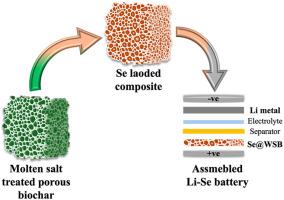采用共晶熔盐热解技术从小麦秸秆中制备多孔生物炭,用于高性能锂硒电池系统
IF 5.8
2区 生物学
Q1 AGRICULTURAL ENGINEERING
引用次数: 0
摘要
合成一种经济上可行且可持续的多孔碳作为锂硒(Li-Se)电池系统的功能电极仍然是一个挑战。本研究探讨了利用废麦秸合成由ZnCl2-NaCl-KCl和MgCl2-KCl-NaCl混合盐活化的多孔生物炭用于锂硒电池的潜力。合成的WSB-Zn多孔生物炭的比表面积为417.54 m2 g−1,孔径为2.05 nm。采用熔融扩散法制备了复合材料,并对其进行了分析。循环稳定性测试(100次循环)表明,在42.8% Se负载下,Se@WSB-Zn复合材料在0.5 C时的比容量为593.43 mAh g - 1,甚至在300次循环后,在1 C时的可逆容量为497.50 mAh g - 1,在2.5C时的倍率性能为373.61 mAh g - 1。该材料经镁盐(MgCl2-KCl-NaCl)活化,命名为WSB-Mg,得到了含有33.6% Se的Se@WSB-Mg复合材料,300次循环后的比容量为356.73 mAh g−1。这项工作提供了将麦秸衍生的多孔碳结构通过熔盐结合到Li-Se电池中的观点,为合成先进的硒基复合材料作为阴极提供了一种经济和环保的方法。本文章由计算机程序翻译,如有差异,请以英文原文为准。

Designing porous biochar from wheat straw by eutectic molten salt pyrolysis for high-performance Li-Se battery systems
The synthesis of an economically viable and sustainable porous carbon as a functioning electrode for lithium-selenium (Li-Se) battery systems is still a challenge. This study investigates the potential of employing waste wheat straw for synthesizing porous biochar activated by ZnCl2-NaCl-KCl and MgCl2-KCl-NaCl salt mixtures for Li-Se batteries. The synthesized WSB-Zn porous biochar exhibited a surface area of 417.54 m2 g−1 and a 2.05 nm pore diameter. The composites were synthesized via melt-diffusion technique and analyzed. Cycle stability tests (100 cycles) demonstrate that the Se@WSB-Zn composite, with 42.8 % Se loading, exhibited an admirable specific capacity of 593.43 mAh g−1 at 0.5 C. It further showed a reversible capacity of 497.50 mAh g−1 at 1 C even after 300 cycles and a rate performance of 373.61 mAh g−1 at 2.5C. The material activated with magnesium salt (MgCl2-KCl-NaCl), named WSB-Mg, resulted in the Se@WSB-Mg composite which consisted of 33.6 % Se and sustained cycling stability with a specific capacity of 356.73 mAh g−1 after 300 cycles. This work provides an insight into the perspective of incorporating wheat straw-derived porous carbon structures achieved by molten salts into Li-Se batteries, offering an economical and eco-friendly approach for the synthesis of advanced selenium-based composites as cathodes.
求助全文
通过发布文献求助,成功后即可免费获取论文全文。
去求助
来源期刊

Biomass & Bioenergy
工程技术-能源与燃料
CiteScore
11.50
自引率
3.30%
发文量
258
审稿时长
60 days
期刊介绍:
Biomass & Bioenergy is an international journal publishing original research papers and short communications, review articles and case studies on biological resources, chemical and biological processes, and biomass products for new renewable sources of energy and materials.
The scope of the journal extends to the environmental, management and economic aspects of biomass and bioenergy.
Key areas covered by the journal:
• Biomass: sources, energy crop production processes, genetic improvements, composition. Please note that research on these biomass subjects must be linked directly to bioenergy generation.
• Biological Residues: residues/rests from agricultural production, forestry and plantations (palm, sugar etc), processing industries, and municipal sources (MSW). Papers on the use of biomass residues through innovative processes/technological novelty and/or consideration of feedstock/system sustainability (or unsustainability) are welcomed. However waste treatment processes and pollution control or mitigation which are only tangentially related to bioenergy are not in the scope of the journal, as they are more suited to publications in the environmental arena. Papers that describe conventional waste streams (ie well described in existing literature) that do not empirically address ''new'' added value from the process are not suitable for submission to the journal.
• Bioenergy Processes: fermentations, thermochemical conversions, liquid and gaseous fuels, and petrochemical substitutes
• Bioenergy Utilization: direct combustion, gasification, electricity production, chemical processes, and by-product remediation
• Biomass and the Environment: carbon cycle, the net energy efficiency of bioenergy systems, assessment of sustainability, and biodiversity issues.
 求助内容:
求助内容: 应助结果提醒方式:
应助结果提醒方式:


